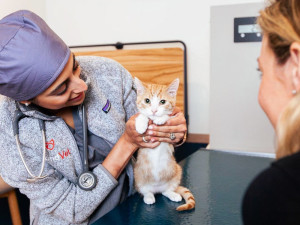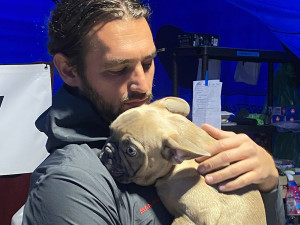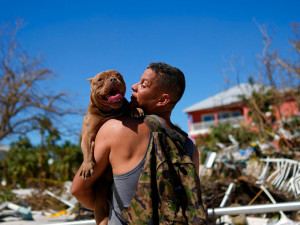We Need to Talk: There’s a Serious Veterinarian Shortage Right Now
As a pet parent, the best thing you can do is be nice.

share article

Your pet wants you to read our newsletter. (Then give them a treat.)
There’s a big problem for everyone seeking medical care for their new family members, and they might not even know it: We’re in the middle of a veterinary workforce crisisopens in a new tab.
“There is a constant need for veterinarian help in both relief and full time capacities,” Dr. Marisa Altieri, a relief small animal veterinarian who works in both Colorado in and New York, tells The Wildest. “As a member of various veterinarian relief groups on social media, this appears to be the resounding theme nationwide.”
“It’s now common to see emergency clinics diverting patients or closing their doors for days at a time because they don’t have enough staff to meet the demand,” Dr. Alycia Washington, a veterinarian in North Carolina, confirms. “Diverting used to be reserved for extreme circumstances, and shutting down was unheard of, but now hospitals are living in crisis mode and have been for the past few years.”
But while the crisis may have reached alarming heights during the pandemic, in reality, it has been building for years — and for many reasons.
Why Is It Happening?
Many people say that so many American households welcomed new pets during the pandemic — 23 millionopens in a new tab Americans by the ASPCA’s estimate — is the reason for this shortage. But other factors — some specifically related to the pandemic and others rooted in longstanding issues in the field — are also at play.
In the early months of the pandemic, vets largely saw only the most urgent cases. That created a backlog in wellness visits that, in addition to appointments for newly adopted pets, caused the demand for vet appointments to increase. In fact, vet appointments did increase opens in a new tabby 4.5 percent from 2019 to 2020 and by 6.5 percent between January and June 2021, compared with the same period in 2020.
At the same time, vets couldn’t see as many pets during the pandemic as they could before it. According to dataopens in a new tab from the AVMA Census of Veterinarians and Veterinary Practice Owners, veterinarians saw fewer patients per hour, and average productivity declined by almost 25 percent in 2020 compared with 2019. Why? Increased safety COVID protocols likely slowed down veterinarians’ ability to see more patients. In addition, transitioning to curbside care, sanitizing exam rooms more frequently, and many other risk-reduction practices took time.
These new protocols were compounded by decreased staff. Like those working on the frontlines of the pandemic in other capacities, many vets left their jobs because they felt “unsafe or concerned about being sick” and either left the workforce entirely or took jobs “in other places where they maybe didn’t need to have so much face time with clients,” Dr. Fox says.
The Problem Already Existed
Turnover was a significant issue in the veterinary field before the pandemic. The annual turnover rate among vet techs was 23.4 percent a year as of January 2020,according to an American Animal Hospital Association surveyopens in a new tab that year — one of the highest turnover ratesopens in a new tab of all healthcare positions. The veterinarian turnover rate was also already twice as high opens in a new tabas it is for physicians prior to the pandemic.
But, according to Dr. Washington, it seems to increasingly be the case that practices aren’t replacing vets who leave at the same rate, “so workloads and wait times increase for whoever’s left.” Dr. Amy Fox, a New York City veterinarian with a background in rescue, agrees, noting that vets who continue to practice amid this shortage are not only affected by staffing issues in their own clinics but also by the short staffing of other clinics in their area. Any practice that “did have staff were just getting slammed with all of the extra clients and patients and emergencies,” she says.
It’s a cycle that — understandably — leads to burnout for many in the field. “I’ve noticed more dramatic and more widespread burnout, and not just with veterinarians, but with every position in the hospital,” Dr. Washington adds.
This is especially true for client-facing employees at vet practices, who “often bear the brunt of pet parents’ frustrations when they are not able to get a sick pet in for an appointment or unable to speak with their vet in regards to test results in a timely fashion,” Dr. Altieri points out. Dr. Fox adds that veterinarians and vet techs “can sometimes end up being a punching bag for clients who are really upset or frustrated when they receive bad news or find out they cannot afford the necessary treatment for their pets.”
This situational burnout is compounded the burnout many in the veterinary field already faced. “I think health professionals often experience a degree of compassion fatigue and burnout as a combination of the work being really difficult emotionally and on top of it you’re working a lot of hours, and you don’t necessarily have the time to practice any kind of self care,” she says.
In fact, one in six veterinarians have contemplated suicide, accordingopens in a new tab to an American Medical Veterinary Association report, and veterinarians are nearly three times more likely than the general public to die by suicide. “It’s a little bit of a powder keg; it can be very, very stressful and really sad some days,” Dr. Fox summarizes. “So I think when you combine all of those things together it’s definitely challenging.”
In some states and practices, vet techs make less opens in a new tabthan a starting wage at McDonald’s. The average salary for veterinarians is less than half of what most medical doctors make in the U.S. Vets’ median salaryopens in a new tab was just under $100,000 in 2020, while some of the lowest-paid doctors opens in a new tabmade around $200,000 the same year.
On top of those salary issues Dr. Fox says, is the “really high student debtopens in a new tab burden that most veterinarians have, and so it’s just made certain parts of the country especially difficult to live and work in.”
What Can Be Done?
A natural place to start: better pay — not just for veterinarians, but everyone in the field.
“Skilled, dedicated support staff are worth their weight in gold, and they should be paid accordingly,” Dr. Washington says. “Many technicians, assistants, and receptionists are still in the field because they care, not because they are paid what they’re worth. Once they’re gone, we’re all out of luck. Veterinarians can’t practice quality medicine without help.”
While vets are paid relatively better than those in support positions, the student debt needed to obtain a veterinary degree can negate the benefits of that salary. “I think, like so many other professions, if there were better options for paying back student debt and getting out of debt and being able to have a decent quality of life, that would help people choose this field,” Dr. Fox says, adding that the ratio of debt-to-salary for veterinarians “deters people from going into the field, even if they’re really passionate about taking care of animals.”
There is also room for significant changes that could happen in the industry. Vets are expected to work long hours, Dr. Fox says, and taking sick days or taking time to address childcare issues are not widely accepted. Extending grace to vet professionals and valuing work-life balance could go a long way, as could “making sure that staff feel appreciated, both financially and emotionally,” Dr. Fox says. “I think that if more clinics prioritize that, they would hold on to their staff more and that would help somewhat with the shortage.”
How Pet Parents Can Advocate For Their Pets Right Now
Until these changes happen, though, pet parents are still left in a difficult situation. The best way to handle it?
“It’s always best to try to address something early,” Dr. Fox says. “If a pet parent notices something is wrong with their pet, even if it seems minor, it’s best to get an appointment, even if it’s a week out, when it’s not an emergency and start addressing the problem instead of ignoring it or hoping it’s going to go away.” Even if nothing appears wrong with your pet, maintaining annual or semi-annual check ups can also go a long way.
“Stay on top of your routine and preventative care,” Dr. Washington says. “Managing early-stage disease is much easier than getting a diagnosis during a crisis. Also, many general practitioners are only able to provide services to their current clients, so if you wait around and only go to the vet when there’s a problem every few years, you may not be in that pool anymore.”
There’s plenty pet parents can do for vets as well. “Be kind and be patientopens in a new tab,” Dr. Washington advises. “Yelling and threatening just leads to more people leaving the field and fewer pets being helped.”
Vet staffs across the country are “doing their best, but probably have worked way more hours than they wanted to and skipped more lunches than they should,” Dr. Fox adds. “Just try to be understanding of that.”

Julie Zeilinger
Julie Zeilinger is a NYC-based writer and editor whose writing has been published in Marie Claire, Vox, HuffPost, Forbes, and other publications. She is also the author of two books: College 101: A Girl’s Guide to Freshman Yearopens in a new tab (2014) and A Little F’d Up: Why Feminism Is Not a Dirty Wordopens in a new tab (2012). She is the mom to Baloo, a two-year-old Bichpoo and foster mom to dogs via Badass Animal Rescueopens in a new tab.
Related articles
![Andrew Kushnir, Nomad Vet, with pug]() opens in a new tab
opens in a new tabMeet Andrew Kushnir, “the Nomad Vet” Helping Refugee Pets in Ukraine
The veterinarian on helping out, making a difference, and the finer things in life (mostly dogs and music).
![a person holds a large dog surrounded by hurricane damage]() opens in a new tab
opens in a new tabHow to Help the Animals Affected by Hurricane Ian
Here’s a list of orgs assisting with rescue efforts.
![Four dogs standing on a fallen tree surrounded by water from a flood from hurricane Fiona.]() opens in a new tab
opens in a new tabHow to Help Dogs and Cats Affected by Hurricane Fiona
Rescue organizations are in need of donations (and adoptions) after the devastating storm.







